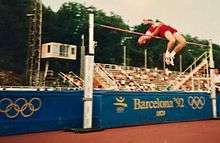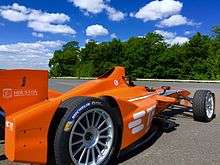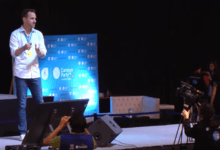Nic Radford
Nicolaus Adam Radford known as Nic Radford (born November 5, 1977) is an American engineer, roboticist, inventor, and serial entrepreneur raising over $26M in funding for his companies. He co-founded and is currently chief technology officer, Houston Mechatronics, Inc (HMI.)[1][2] Prior to forming HMI, he spent 14 years at Lyndon B. Johnson Space Center's Dexterous Robotics Laboratory at NASA in Houston, Texas. Radford was the principal investigator tasked with leading the development of Valkyrie for participation in the 2013 DARPA Robotics Challenge (DRC) and NASA's future Mars robotics missions.
Nicolaus Radford | |
|---|---|
 Radford in 2015 | |
| Born | Nicolaus Adam Radford November 5, 1977 |
| Nationality | American |
| Alma mater | Purdue University |
| Occupation | Engineer Roboticist Inventor Entrepreneur |
| Website | houstonmechatronics |
Preceding the DRC, he operated as deputy and chief engineer for Robonaut 2 (R2), a humanoid robot that was developed in partnership between NASA and General Motors.[3] Additionally, during his tenure at NASA, he became a leader in wearable robotics and exoskeletons for spaceflight, rehabilitation, and abled body human performance augmentation.[4][5] Radford is active in the areas of electric motor design towards robotics and electric cars, winning awards for his research in variable flux technology.[6] Radford holds numerous patents, has authored several publications, and earned a BSEE and a MSEE both from Purdue University.[1][6][7] In 2017, Radford was the recipient of the Houston Business Journal's Top 40 Under 40 Award.[8][9]
Early life and education

Born in Champaign, Illinois, United States, Radford's family moved to Indiana when he was two months old, settling in Columbus when he was five. He attended Columbus North High School and excelled in track and field, namely high jump, where he set the indoor/outdoor record, and high hurdling, as well as varsity football.[10] He was the 1996 recipient of the Dr. McKain Award for demonstrating "high character as a student and as a citizen in the community."[11] He attended Purdue University and received his Bachelor of Science in Electrical and Computer Engineering in 2000. While at Purdue, Radford was a member of the Purdue Engineering Student Council and participated in Purdue Track and Field as a decathlete.[12][13] A chronic ankle injury prevented him from pursuing track beyond his freshman year.
After starting his career at NASA-JSC, he attended graduate school remotely at Purdue University and received his Master of Science in Electrical and Computer Engineering in 2012.[14] His research, sponsored by Dr. Gill Pratt of DARPA, was in a new class of electric motors and his thesis was entitled, "Analysis and Design of a Variable Flux Memory Motor for a Humanoid Robot Application."[15] He was the recipient of the Grainger Foundation Outstanding Power and Energy Devices and Systems Award in April 2012, for his contribution to the field of Variable Flux Memory Motors.[6] In 2010, he discussed how his time at Purdue prepared him for his future endeavors, "Purdue is a very hands-on, laboratory- and design-oriented university. This equipped me well for my work at NASA. You truly understand the value of Purdue once you get out and have a little perspective. It offers an education that goes beyond textbooks.[16]
Career
Early career
After graduating from Purdue University with his BSEE, Radford moved to Houston, Texas initially for a position with United Space Alliance as a robotics flight controller in the payload deployment retrieval system (PDRS) console in NASA's Mission Control Center (MCC). During this time, Radford co-founded the Amateur Spaceflight Association,[17] a group of engineers that worked in their free time to become the first amateur group to launch a rocket into space.[18][19] He developed the rocket's avionics and ground control subsystems and was able to secure Rabbit Semiconductor financial support for development of the avionic subsystems.[20] ASA had garnered so much attention that the Houston Chronicle covered the amateur space race competition between themselves and the Civilian Space eXploration Team (CXST), another amateur rocket group with the same aspiration.[21] He then was employed by Oceaneering Space Systems as an electrical engineer contractor to NASA, where he worked onsite at JSC and became involved with the Dexterous Robotics Laboratory. Additionally for five years, he volunteered as a mentor for high school teams competing in the FIRST Robotics Competition, working with Team 118 Robonauts.
NASA
In 2008, Radford became a civil servant at NASA as chief engineer and deputy project manager for Robonaut 2, under Direct Hire Authority (DHA). This allowed the Office of Personnel Management (OPM) to expedite staffing requests to fill "a critical hiring need."[22][23] He led large multidisciplinary teams of engineering staff in project endeavors for developing Robonaut 2, X1 Exoskeleton,[24][25] DARPA's Warrior Web, as well as leading R2's redesign and qualification efforts for the International Space Station, which flew to ISS aboard Space Shuttle Discovery's final flight STS-133.[1][6][26][27][28][29] In 2011, Radford became the principal investigator for NASA in the DARPA Robotics Challenge (DRC). He led a team of 55 engineers and technicians through design, development and field testing NASA's first full humanoid robot, created to aid in disaster relief efforts.[1][30][31][32] He used this opportunity to create a very controversial female robot,[33] as a source of inspiration for girls with STEM related endeavors. His team based Valkyrie's form on "armor worn by women throughout history" as well as a "nod to the Valkyries of Norse mythology." Valkyrie's name was also a tribute to previous NASA developed prototypes, including the North American XB-70 Valkyrie bomber, as well as an earlier robot Team 118 Robonauts created for FIRST.
In Slate's 2015 article "Bot Looks Like a Lady", Radford discussed how NASA "missed a big opportunity" to inspire a new generation of women and girls, in maintaining their official stance that Valkyrie is gender neutral. He referred to his then seven-year-old daughter as proof, "She absolutely was in love with this robot. It was a major source of inspiration for her. She talked about it all the time. She drew pictures of Valkyrie." [34] IEEE Spectrum's video where Radford introduced Valkyrie as NASA's Superhero Robot acquired over 2 million views.[35] Radford attempted to shed light on the controversy indicating that Valkyrie was designed to be of the female form from the beginning.[33]
Houston Mechatronics, Inc

HMI was established in 2014 with co-founders Matt Ondler and Dr. Reg Berka. Radford drives the vision of HMI.[36] "He is responsible for building and growing HMI as a subsea robotics and mechatronics company in both energy and military domains."[37][38] Early in the company's life, in 2015, HMI teamed up with Andretti Technologies to develop a new electric motor for Season Two of Formula E Racing.[39] Due to lack of funding from Andretti, the motor was never fully completed and only saw the initial phase of track testing. In 2016, Andretti announced a new direction for Season Three and each party dissolved their partnership.[40] HMI has secured Series A Funding with Schlumberger Technology Investments and licenses Purdue technology "that could optimize electric motor and design better alternatives in automation in the energy sector."[41] By March 2017, Radford had raised a total of $23M in venture capital funding for HMI by also securing Series B Funding.[42][43]
Radford has given many interviews and several invited talks on the subject.[6][44][45][46] In 2015, he appeared in the documentary 'Ancient Aliens 2015: Aliens and Robots.'[47]
The company began working on an autonomous unmanned undersea vehicle (UUV), Aquanaut, capable of operating deeper than 3,000 m in December 2017.[48]
Career achievements
Patents
- Robot[49]
- Connector pin and method[50]
- Method and apparatus for electromagnetically braking a motor[51]
- System and method for calibrating a rotary absolute position sensor[52]
- Rotary series elastic actuator[53]
- Integrated high-speed torque control system for a robotic joint[54]
- Bipedal exoskeleton and methods of use[55]
- Re-Configurable Subsea Robot
Publications
- Editor for Springer Humanoid Handbook[56]
- The Robonaut 2 Hand – Designed to do Work with Tools[57]
- Robonaut 2 – The First Humanoid Robot in Space[58]
- Mobile Manipulation Using NASA's Robonaut[59]
- Innovative Robot Archetypes for In-Space Construction and Maintenance[60]
- Forming Human-Robot Teams Across Time and Space[61]
- Robonaut 2 – Initial Activities On-Board the ISS[62]
- Valkyrie: NASA's First Bipedal Humanoid Robot[63]
- Actuator Control for the NASA-JSC Valkyrie Humanoid Robot: A Decoupled Dynamics Approach for Torque Control for Series Elastic Robots[64]
- Robot Task Commander: A Framework and IDE for Robot Application Development[65]
Awards
In 2014, Radford was awarded the NASA Outstanding Leadership Medal, one of NASA's most prestigious awards for his efforts developing NASA's Valkyrie Humanoid robot.[1][38] Radford is the 2017 recipient of the Houston Business Journal's Top 40 Under 40 Award. This award honors the brightest young business people who contribute to their companies, industries and community in an impressive way.[9][9]
- 2012 Grainger Award[6]
- 2014 Government Invention of the Year[66]
- 2014 NASA Outstanding Leadership Medal
- 2017 Houston Business Journal's Top 40 Under 40 Award
Notable invited talks

- Keynote Speaker at International Human-Centered Robotics Symposium, November 2013, hosted by the University of Cincinnati.[6]
- 2013 Speaker at Cyber-Physical Systems Week[67][68]
- 2014 Robotics: Science and Systems Conference[69]
- WearRA Wearable Robotics Association[45]
- Campus Party Mexico 2016[46]
- Keynote Speaker at INNOROBO: Impact and Challenges of the Robotics Revolution, May 2016, hosted in Paris, France[44]
- Guest Lecturer at Masdar University in Abu Dhabi[70]
- SPACECOM December 2017[71]
- .NEXT [72][73]
- Frontier Conference, April 2018[74]
- International Conference for Robotics and Automation in 2018, hosted in Brisbane, Australia[75]
Influences and inspiration
Radford's papers and works have been cited over 450 times.[76] As one of 17 prominent roboticists to respond to IEEE Spectrum's May 23, 2016 article asking what Google should do with its Boston Dynamics robots, Radford stated, "Google is probably one of a handful of companies with the resources to actually solve the humanoid robot challenge. And it is a solvable problem; it just requires some significant investment and tenacity to leave them alone and let them work. But unfortunately, for better or worse, the problems that are making money robotics today and tomorrow on the surface are far less sexy."[77]
Radford's biggest inspiration is the challenge. According to his interview in IEEE Spectrum's article "Houston Mechatronics Raises $20M to Bring NASA Expertise to Transforming Robot Submersibles," Radford states, "Personally, I’ve found the transition to be invigorating. Starting a company is quite different than working for a government robotics research lab, but probably the biggest difference is the risk posture: startups are all about huge risks for huge returns. There is something so palatable about taking on the entrenched establishment in an industry, calling them out and saying, "I know you’ve been here for a while, but I think you’re doing it all wrong." There's a reason NASA didn't start SpaceX; oftentimes established organizations don't know of any other way to do what they do, and that's what's so thrilling about starting a new company— taking the risks."[43]
References
- Maitre, Jade Le (24 February 2016). "An Interview With Houston Mechatronics, Inc Co-Founder, and CTO Nicolaus Radford - Innorobo Community". thedisruptory.com. Retrieved 31 January 2017.
- "Exclusive: Nasa scientists set to revolutionise oil and gas business with robotics and automation technology". roboticsandautomationnews.com. 7 September 2016. Retrieved 31 January 2017.
- "Robonaut2". Robonaut.jsc.nasa.gov. Retrieved 2017-02-25.
- Wright, Jerry (13 April 2015). "Robotic Technology Lends More Than Just a Helping Hand". nasa.gov. Retrieved 31 January 2017.
- "NASA's Exoskeleton for Astronauts & Paraplegic Patients - Video". space.com. Retrieved 31 January 2017.
- "Nicolaus A Radford". uc.edu. Retrieved 31 January 2017.
- "Archived copy". Archived from the original on 2016-06-06. Retrieved 2017-01-31.CS1 maint: archived copy as title (link)
- http://www.bizjournals.com/houston/news/2017/04/06/hbj-reveals-the-40-under-40-class-of-2017-honorees.html
- http://www.bizjournals.com/houston/news/2017/04/06/hbj-reveals-the-40-under-40-class-of-2017-honorees.html?ana=fbk#g30
- "Columbus North High School CN Boys Track & Field Records". www.columbusnorthathletics.org. Retrieved 2019-10-08.
- "Non Sport Athletic Awards – Historic Columbus Indiana Message Board". proboards.com. Retrieved 31 January 2017.
- "PURDUESPORTS.COM – PURDUESPORTS.COM – Purdue University Official Athletic Site – Events". purduesports.com. Retrieved 31 January 2017.
- "PURDUESPORTS.COM – PURDUESPORTS.COM – Purdue University Official Athletic Site – Events". purduesports.com. Retrieved 31 January 2017.
- "Life among the Robonauts". College of Engineering - Purdue University. Retrieved 2019-10-08.
- Radford, Nicolaus A. (1 January 2012). "Analysis and design of a Variable Flux Memory Motor for a humanoid robot application". Retrieved 31 January 2017 – via gradworks.umi.com.
- "Life among the Robonauts". purdue.edu. Retrieved 31 January 2017.
- "AMATEUR SPACEFLIGHT ASSOCIATION in Texas". associationdatabase.org. Retrieved 31 January 2017.
- "Spaceport to host Amateur Spaceflight launch". chron.com. Retrieved 31 January 2017.
- "Spaceport to host Amateur Spaceflight launch". yourhoustonnews.com. Retrieved 31 January 2017.
- "Using a Rabbit Is not Rocket Science…Or is it?_仪器仪表_中国百科网". Chinabaike.com. Retrieved 2017-02-25.
- "Race is on to build first amateur rocket to reach space". chron.com. Retrieved 31 January 2017.
- "Hiring Options NASA Headquarters Can Use Without OPM Approval" (PDF). Fasd.hq.nasa.gov. Retrieved 2017-02-25.
- "The Space Station's Robot Butler Turns On". popularmechanics.com. 1 September 2011. Retrieved 31 January 2017.
- "NASA's strange robotic suit could pave way to Mars, make astronauts safe -". sciencerecorder.com. Retrieved 31 January 2017.
- "Robotic Suit Aids Astronauts and Paraplegic Patients". space.com. Retrieved 31 January 2017.
- "Meet Robonaut 2, The Humanoid Robot That's In Space Right Now". businessinsider.com. Retrieved 31 January 2017.
- "Robot astronaut powered up for first time in space". tgdaily.com. Retrieved 31 January 2017.
- "Robonaut Wakes Up In Space". spacedaily.com. Retrieved 31 January 2017.
- "NASA Ready to Send Humanoid Robot to Space". ieee.org. Retrieved 31 January 2017.
- "Meet NASA's new humanoid robot Valkyrie". cbsnews.com. Retrieved 31 January 2017.
- "The Human Centered Robotics Group – Page 3 – Decision and Control of Human Centered Robots". utexas.edu. Retrieved 31 January 2017.
- Allen, Greg. "Robot 'Olympics' Test Machines On Human Skills". usf.edu. Retrieved 31 January 2017.
- "Video Friday: Pneumatic RoboDog, Drone Crash, and Nao With Eyebrows". ieee.org. Retrieved 31 January 2017.
- Dattaro, Laura (4 February 2015). "Bot Looks Like a Lady". Slate. Retrieved 31 January 2017.
- IEEE Spectrum (10 December 2013). "Valkyrie: NASA's Superhero Robot". Retrieved 31 January 2017 – via YouTube.
- https://dronebelow.com/2018/04/27/houston-mechanics-deep-sea-underwater-robotics-20m-funding/
- https://www.linkedin.com/in/nicolaus-radford-375b9865/
- Work, Design At. "Roboticists, Engineers & Innovators ǀ Houston Mechatronics – Houston Mechatronics". houstonmechatronics.com. Archived from the original on 14 February 2017. Retrieved 31 January 2017.
- Inc., Houston Mechatronics. "Houston Mechatronics and Andretti Technologies Team to Develop an Advanced Powertrain for Formula E Racing". prnewswire.com. Retrieved 31 January 2017.
- Mitchell, Scott. "Andretti completes first on-track testing with new FE powertrain". autosport.com. Retrieved 31 January 2017.
- "Startup licenses Purdue technology to help make robotics, electric cars more efficient, cost effective – Purdue University". purdue.edu. Retrieved 31 January 2017.
- https://www.crunchbase.com/organization/houston-mechatronics#section-locked-marketplace
- https://spectrum.ieee.org/automaton/robotics/industrial-robots/houston-mechatronics-raises-20m-to-bring-nasa-expertise-to-transforming-robot-submersibles
- "Program – The Innorobo Keynote – Innorobo". innorobo.com. Retrieved 31 January 2017.
- "Leaders in Robotics – Wearable Robotics Association". wearablerobotics.com. Retrieved 31 January 2017.
- "Los 12 ponentes que no te puedes perder en Campus Party 2016". dineroenimagen.com. Retrieved 31 January 2017.
- "YouTube". youtube.com. Retrieved 31 January 2017.
- "Houston company developing UUV to manipulate at extreme depth without umbilical | Jane's 360". www.janes.com. Retrieved 2018-07-19.
- "United States Patent: D628609 – Robot". uspto.gov. Retrieved 31 January 2017.
- "United States Patent: 8033876 – Connector pin and method". uspto.gov. Retrieved 31 January 2017.
- "United States Patent: 8067909 – Method and apparatus for electromagnetically braking a motor". uspto.gov. Retrieved 31 January 2017.
- "United States Patent: 8250901 – System and method for calibrating a rotary absolute position sensor". uspto.gov. Retrieved 31 January 2017.
- "United States Patent: 8291788 – Rotary series elastic actuator". uspto.gov. Retrieved 31 January 2017.
- "United States Patent: 8442684 – Integrated high-speed torque control system for a robotic joint". uspto.gov. Retrieved 31 January 2017.
- "Bipedal Exoskeleton and Methods of Use". google.com. Retrieved 31 January 2017.
- "Editors' Recognition Award for Distinction in Reviewing 2013" (PDF). Springer.com. Retrieved 2017-02-25.
- "The Robonaut 2 Hand – Designed To Do Work With Tools" (PDF). Ntrs.nasa.gov. Retrieved 2017-02-25.
- "Robonaut 2 – The first humanoid robot in space (PDF Download Available)". researchgate.net. Retrieved 31 January 2017.
- "Mobile Manipulation using NASA's Robonaut" (PDF). Graphics.cs.cmu.edu. Retrieved 2017-02-25.
- "Innovative Robot Archetypes for In-Space Construction and Maintenance (PDF Download Available)". researchgate.net. Retrieved 31 January 2017.
- Hambuchen, Kimberly; Burridge, Robert R.; Ambrose, Robert O.; Bluethmann, William J.; Diftler, Myron A.; Radford, Nicolaus A. (22 May 2012). "Forming Human-Robot Teams Across Time and Space". Retrieved 31 January 2017 – via NASA NTRS.
- "Robonaut 2 – Initial Activities On-Board the ISS" (PDF). Ntrs.nasa.gov. Retrieved 2017-02-25.
- "Valkyrie: NASA's First Bipedal Humanoid Robot" (PDF). Pdfs.semanticsscholar.org. Retrieved 2017-02-25.
- "Actuator Control for the NASA-JSC Valkyrie Humanoid Robot: A Decoupled Dynamics Approach for Torque Control of Series Elastic Robots (PDF Download Available)". researchgate.net. Retrieved 31 January 2017.
- "Robot Task Commander: A framework and IDE for robot application development (PDF Download Available)" (PDF). Researchgate.net. 2015-11-17. Retrieved 2017-02-25.
- Roberts, Jason (1 May 2015). "Robonaut 2 Lauded as 2014 Government Invention of the Year". nasa.gov. Retrieved 31 January 2017.
- "Speakers". formalcomp.com. Retrieved 31 January 2017.
- "CPS Week 2017 – April 18-21 – Pittsburgh, PA". cmu.edu. Retrieved 31 January 2017.
- "SAT 1. 5th Workshop on Formal Methods for Robotics and Automation" (PDF). Rll.berkeley.edu. Retrieved 2017-02-25.
- https://twitter.com/HoustonMech/status/920340746338754560
- http://expo.spacecomexpo.com/SPC17/Public/speakers.aspx
- https://www.nutanix.com/go/next-dc-keynotes.php
- http://dev.ntnxdev.com/next/speakers.html
- http://thefrontier.co/2018/
- https://torquecontrolledactuatorcriteria.wordpress.com/program/
- https://www.researchgate.net/profile/Nicolaus_Radford
- "What 17 Prominent Roboticists Think Google Should Do With Its Robots". ieee.org. Retrieved 31 January 2017.